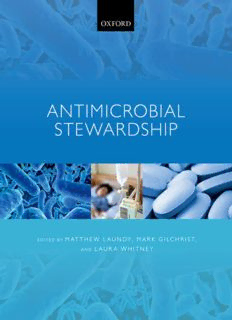
Antimicrobial stewardship PDF
Preview Antimicrobial stewardship
Antimicrobial stewardship Antimicrobial stewardship Edited by Matthew Laundy Mark Gilchrist Laura Whitney 1 1 Great Clarendon Street, Oxford, OX2 6DP, United Kingdom Oxford University Press is a department of the University of Oxford. It furthers the University’s objective of excellence in research, scholarship, and education by publishing worldwide. Oxford is a registered trade mark of Oxford University Press in the UK and in certain other countries © Oxford University Press 2016 The moral rights of the authors have been asserted First Edition published in 2016 Impression: 1 All rights reserved. No part of this publication may be reproduced, stored in a retrieval system, or transmitted, in any form or by any means, without the prior permission in writing of Oxford University Press, or as expressly permitted by law, by licence or under terms agreed with the appropriate reprographics rights organization. Enquiries concerning reproduction outside the scope of the above should be sent to the Rights Department, Oxford University Press, at the address above You must not circulate this work in any other form and you must impose this same condition on any acquirer Published in the United States of America by Oxford University Press 198 Madison Avenue, New York, NY 10016, United States of America British Library Cataloguing in Publication Data Data available Library of Congress Control Number: 2016934615 ISBN 978– 0– 19– 875879– 2 Printed and bound by CPI Group (UK) Ltd, Croydon, CR0 4YY Oxford University Press makes no representation, express or implied, that the drug dosages in this book are correct. Readers must therefore always check the product information and clinical procedures with the most up- to- date published product information and data sheets provided by the manufacturers and the most recent codes of conduct and safety regulations. The authors and the publishers do not accept responsibility or legal liability for any errors in the text or for the misuse or misapplication of material in this work. Except where otherwise stated, drug dosages and recommendations are for the non-p regnant adult who is not breast- feeding Links to third party websites are provided by Oxford in good faith and for information only. Oxford disclaims any responsibility for the materials contained in any third party website referenced in this work. To our children: Amelia, Freya, Jacob, and Sophie. May our actions now make a safer future for you. The fault, dear Brutus, is not in our stars. But in ourselves, that we are underlings. Julius Caesar (Act I, Sc. II) William Shakespeare Preface The twentieth century has been described as the golden age of antimicrobials. With the introduc- tion of antimicrobials previously deadly infectious diseases were relegated to history. Now in the second decade of the twenty- first century it has become increasingly obvious to even the most disinterested member of the public, healthcare professional, or politician that there is a problem with antimicrobial- resistant organisms and untreatable infections. This problem of antimicrobial resistance has been raised as a worldwide concern alongside global warming, and the popular press regularly raises the spectre of a ‘return to the dark ages’. While resistance is an inevitable evolutionary process, two factors have accelerated the devel- opment of untreatable infections. Firstly the pharmaceutical industry had lost interest in anti- microbial development, primarily for financial reasons, and so there are fewer new classes of antimicrobials in the pipeline as a consequence. The second is the overuse and abuse of antimi- crobials by the medical profession, the public, and the agricultural industry. The concept of antimicrobial stewardship has been developing within the infection community over the last 15 years. The aim of antimicrobial stewardship is to restrict antimicrobial use in order to reduce the development of resistance, avoid the side effects associated with antimicrobial use, and optimize clinical outcomes. In its simplest form it’s about saving what antimicrobials we have. This is a rapidly developing field. The number of academic papers on antimicrobial stewardship has increased dramatically in the past 5 years, from 43 in 2008 to 429 in 2015. Our aim is to produce a very practical approach to antimicrobial stewardship. It’s very much a ‘how to’ guide supported by a review of the available evidence. The book is divided into three sections. Section 1: Setting the scene and starting up: in this section we look at the problem of antimicro- bial resistance, problems in the antimicrobial supply line, and initiatives to improve the situation. We examine the psychological, social, cultural, and organizational factors in antimicrobial use and prescribing. We look at the principles and goals of antimicrobial stewardship. Finally we look at how to establish an antimicrobial stewardship programme. Section 2: Components of an antimicrobial stewardship programme: in this section we examine the identified components of an antimicrobial stewardship programme— prospective audit and feedback, antimicrobial policies and formularies, antimicrobial restriction, intravenous to oral switch, measuring antimicrobial consumption, and measuring and feeding back stewardship; we conclude with a look at information technology in antimicrobial stewardship. Section 3: Special areas in antimicrobial stewardship: in this section we explore specific areas of antimicrobial stewardship including antimicrobial pharmacokinetics and dynamics, intensive care units, paediatrics, surgical prophylaxis, near- patient testing, and infection biomarkers. We will also look at antimicrobial stewardship in the community and long- term care facilities, where arguably there is most to be done. We conclude the book by looking at antimicrobial stewardship in resource- poor settings and the unique challenges facing low- and middle- income countries. Infection control is a vital component in the control of the spread of resistant organisms. We will touch on aspects of infection control, but there are many textbooks that can cover this subject in far more detail that we are able to here. We will not cover the exact mechanisms of antimicro- bial resistance as this field is rapidly developing and the book would soon be out of date, nor is this a pharmacology book on antimicrobials. The issue of the widespread use of antimicrobials in the
Description: